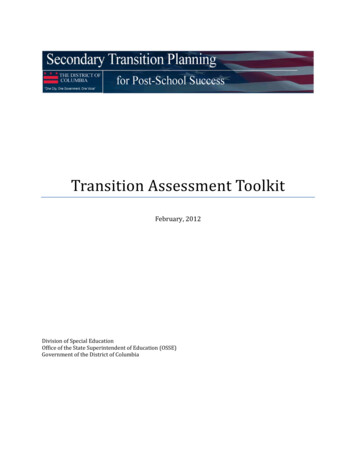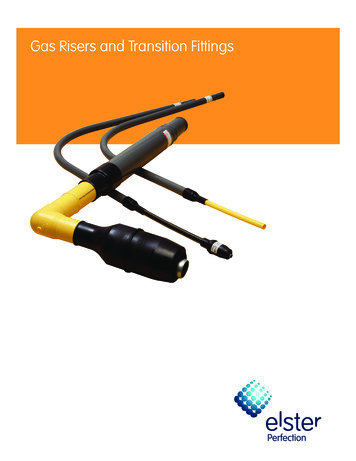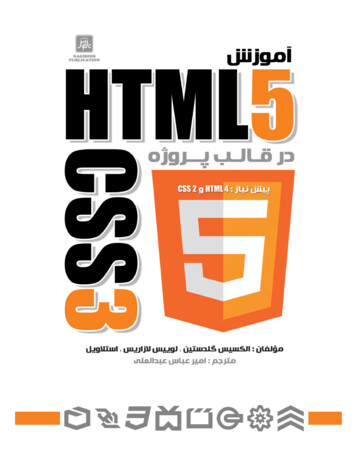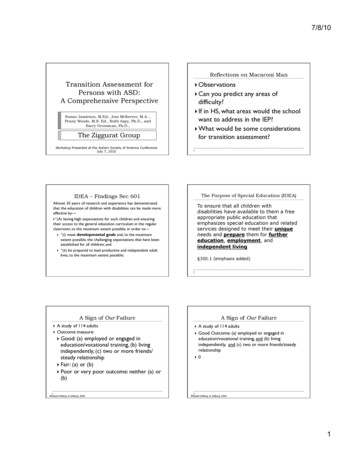
Transcription
Transition Assessment ToolkitFebruary, 2012Division of Special EducationOffice of the State Superintendent of Education (OSSE)Government of the District of Columbia
Transition Assessment ToolkitTable of ContentsOverview of Transition Assessment4Recommended Transition Assessments Transition Assessments Covering All Domains Self‐Determination Student Engagement Assistive Technology Career (Vocational and Employment) Postsecondary Education/Training Independent Living1316252930324346Student Case Studies Student with a Learning Disability & ADHD Student with Autism Spectrum Disorder5357Techniques and Resources for Developing an Individualized TransitionAssessment Process64Additional Free Transition Assessment Online Resources692
Transition Assessment Toolkit3This Transition Assessment Toolkit was developed to support educators in providingtransition services based on age‐appropriate transition assessment data. The toolkitincludes six sections. Brief descriptions of each section are provided below.Overview of Transition AssessmentThe overview provides a brief history of the legislative mandates for transition assessmentand the components within a systemic approach to transition assessment planning andimplementation.Recommended Transition AssessmentsA table of recommended transition assessments with ordering information is followed bydescriptions of each assessment outlining who the assessment is appropriate for, what itmeasures, and how it is administered, as well as an example of assessment results andtransition services. The majority of the recommended assessments are available free toprint or complete online and all assessments within this toolkit can be purchased for lessthan 700. While a multitude of other assessments are available, assessments wereidentified for recommendation based on their array of items and response options, ease ofuse, and price.Student Case StudiesTwo student case studies are provided that demonstrate an ongoing transition assessmentprocess and describe the results of multiple transition assessments. The assessmentsadministered to the case study students were selected based on the students’ individualcharacteristics and transition planning needs.Techniques and Resources for Developing an Individualized Transition AssessmentProcessIt can feel overwhelming to identify appropriate transition assessments that will supporteach student in learning about him or herself and provide the framework for developingIndividual Education Programs (IEPs) that will support each student to move toward his orher postsecondary goals. A variety of techniques and resources are provided within thissection to support the transition assessment process.Additional Free Transition Assessment Online ResourcesThe assessments within this toolkit provide a strong starting point for transitionassessment. Additional free transition assessment resources are provided to support you incontinually expanding your knowledge and skills, as well as to supplement the toolkit withadditional assessments that are helpful for specific students.
Transition Assessment Toolkit4Overview of Transition AssessmentPatricia M. Noonan & Amy Gaumer Erickson, (2011). Reprinted with permission.Need for Transition AssessmentSince 1990, legislation has been in place to ensure that the individualized educationalprogram (IEP) process incorporated student interests and preferences, yet schools stillstruggle to understand the best way to capture and utilize this information. IDEA 2004transition requirements center on transition outcomes, planning processes, and students’strengths, needs, interests and preferences, but actual transition goals often lack qualityand definition, being too broad or vague (Lohrmann‐O’Rourke & Gomez, 2001). Inadequateinformation on students’ strengths, preferences, interests and needs is one of the primaryreasons for the lack of quality and definition in transition goals.Schools have included more appropriate transition assessment measures and methods, yetthey often base the entire assessment process on the protocol of the school or program, notthe needs of the student (Cohen & Spenciner, 1996). For example, transition assessment isoften limited to occupational interests, which provides data that is questionable in manyschool settings (Lohrmann‐O’Rourke & Gomez, 2001). Other research indicates that thefocus on academic achievement in today’s large‐scale academic assessment environmentoften results in too narrow a range of assessment (Sitlington & Clark, 2006).While secondary educators spend time each day assessing students to track academicprogress, target areas for improvement, and provide feedback, few consider the value andsignificance of systematic assessment for planning students’ transitions into postsecondarysettings. This may be due, in part, to negative opinions about testing in general, and therecent pressures of statewide testing for academic performance.Dissatisfaction around traditional assessments can result fromobserving and mirroring poor assessment practices, the inability ofassessment to provide specific information about a student’slearning needs to improve instruction, and the failure of many teststo assess higher order thinking and problem‐solving skills (Daniels,1999). Practitioners continue to struggle to identify the criticalareas of assessment for transition planning, choose appropriateassessment techniques for each student, implement assessmentplans, interpret data and apply data‐‐ all critical components ofmeeting the individualized needs of students with disabilitiesand impacting adult outcomes.Defining Assessment for Transition PlanningEmbodying many different methods and approaches, assessment for transition planning isan umbrella term encompassing any assessment that targets areas critical for a high quality
Transition Assessment Toolkit5adult life for youth with disabilities. The Council for Exceptional Children, Division ofCareer Development and Transition (DCDT) defines transition assessment as: the ongoing process of collecting data on the individual’s strengths, needs,preferences and interests as they relate to the demands of current and futureworking, educational, living, and personal and social environments. Assessmentdata serve as the common thread in the transition process and form the basis fordefining goals and services to be included in the IEP” (Sitlington, 1996).This toolkit provides a general overview of transition assessment, including guidingprinciples, a systematic model of the assessment process, and descriptions of selectedtransition assessments.Guiding Principles of Assessment for Transition PlanningBefore a discussion of recommended practices around the assessment process can occur, itis necessary to address some guiding principles critical to transition assessment. Tounderstand these principles, one must raise the question, “Why assess?”. Concerningtransition planning, assessment fulfills one key function—to facilitate self‐awarenessand family awareness for decision‐making around critical life choices. Rojewski(2002) proposed three core types of principles to guide the planning and implementationof transition assessment: humanistic, holistic, and therapeutic. A humanistic approach acknowledges that assessment should be unique for eachindividual, considering personal needs and situations. Holistic assessment considers the entire person in all relevant environments,including home and family roles, social/interpersonal relationships, and communityliving. Therapeutic assessment strives to reduce anxiety and facilitate growth by providingnumerous opportunities for self‐discovery and life satisfaction.These three principles should be the priority valueswhen planning assessments for youth with disabilities.Adopting these guiding principles will preventassessment solely for the sake of meeting a monitoringrequirement, such as checking a box on an IEP form ordocumenting present levels of performance.The ultimate goal of assessment for transition planningis to help students develop and accept a positive andrealistic self‐image that matches what they want forthemselves after high school. In doing so, four prominent uses of assessments are possible:prediction, discrimination, monitoring, and evaluation (Rojewski, 2002). Prediction isused to help an individual gauge probabilities of success; discrimination is concerned withan individual creating opportunities to match his/her personal preferences with availableoptions; monitoring is used to continually self‐evaluate progress and behavior; andevaluation is used to determine levels of goal achievement (Rojewski, 2002). These fourspecific functions of assessment illustrate how assessments can lead to increased and moreappropriate opportunities based on the individual’s strengths, preferences and interests.
Transition Assessment ToolkitLegislation such as IDEA 2004 and the RehabilitationAct assert that individuals with disabilities should beequal partners with their families and the school inplanning and decision making for their postsecondarygoals. Students and consumers should direct their owneducational, transition, and rehabilitation planningprocess. To do this, they must be sufficiently informed oftheir own strengths, interests, and preferences and howthese relate to adult life (Sitlington, Neubert & Leconte,1997). This is the basic starting point for transitionassessment.6Transition AssessmentStarting PointStudents must be sufficientlyinformed of their ownstrengths, interests, andpreferences and how theserelate to adult life. This willequip them to direct theirown educational, transition,and rehabilitation planningprocess.The success of assessment for transition planning depends greatly on the principles theprocess embodies. That is, if faulty principles underlie an assessment process, such asidentifying only weaknesses and not using a strengths‐based approach, the resulting effortwill be limiting to the individual providing negative documentation of his or herweaknesses. In order to meet the principles of quality transition planning assessment, skillsin self‐determination and student involvement must be fostered and imbedded in thecurriculum as well as the assessment process (Wehmeyer, 2001). The actions of self‐determined people enable them to fulfill roles typically associated with adulthood. Self‐determination can be defined as “acting as the primary causal agent in one’s life andmaking choices and decisions regarding one’s quality of life free from undue externalinfluence or interference” (Wehmeyer, 2001). Self‐discovery leads to knowledge of theindividual person, which better prepares the individual to make choices. Informationgleaned from transition assessments should encourage individuals with disabilities tomake informed choices (Sitlington & Clark, 2006).It is important not only to provide multiple opportunities for the development of self‐determination skills through instruction and participation in student‐directed IEPs (e.g.,Martin, Mithaug, Oliphint, & Husch, 2002), but also to assess self‐determination knowledgeand skills, like any other transition‐relatedknowledge or skill area. Multiple assessmentinstruments can provide insight into levels of self‐determination. Self‐determination is a criticalskill‐set for the transition planning assessmentprocess. It allows students to participate inassessment planning (selecting areas andinstruments or activities), advocate forthemselves in interpretation of assessment data,and engage in matching their data to instruction and service planning.In order to identify strengths (abilities, knowledge, and skills), preferences, and interestshumanistically, holistically, and therapeutically, it is critical to allow students to drive boththe IEP and the transition assessment process to the maximum extent possible. Theperson‐centered planning approach is one useful method. Person‐centered planning is a
Transition Assessment Toolkitprocess for planning and supporting youths that builds uponthe individual's capacity to engage in activities that promotecommunity life which honor the individual's preferences,choices, and abilities. The individual identifies family members,friends, educators and professionals that he/she would like tohave involved in the planning process. The ultimate goal ofperson‐centered planning is to facilitate a lifetime of self‐determination in order to maximize the level of communityinclusion in adult life (Sax & Thoma, 2002).7Students can directlyinfluence thetransition planningassessment process byexpressing interests,preferences, andabilities and helpingdevelop key, targetedquestions to guide theassessment process.In order to facilitate self‐determination and incorporaterecommended practices around person‐centered planning, students with disabilities mustbecome a fully empowered member of the IEP team and provide input on informationgained through assessment. As transition planning assessment often occurs now, studentswith disabilities are passive recipients of assessment activities and seldom see relevance totheir current or future daily lives (Sitlington et al., 1996). Another problem is thattraditional assessment often uses adult language, not the voice of today’s students. Thesolution is that instead of adults primarily gathering data and interpreting results, studentsmust be supported to self‐assess, interpret results, and create goals (Sitlington et al., 1996).Student‐centered transition planning must be based upon an individual’s awarenessof his or her present level of functioning, a personal vision for the future, andknowing what must be done to get where he or she wants to be. (Sitlington et al., p.48).Students can be directly involved in various phases of a transition planningassessment process, such as expressing interests, preferences, and abilities andassisting in the development of key, targeted questions, which serve as overarchingquestions throughout the assessment process. Students can also conduct andparticipate in data‐gathering activities and develop strategies based on assessment results.This focus on student choice and self‐directed activities should be the underlyingcomponent in the development and administration of every transition assessment process.Systematic Approach to Transition AssessmentAs noted in the DCDT definition of assessment for transition planning, it cannot be limitedsolely to vocational/career assessment, but instead must include a more comprehensiveview, by looking at areas such as: independent and interdependent living interests and preferences (life interestsand values as well as occupational),skills, physical health and fitness, recreation and leisure skills, motor skills, self‐determination skills, speech and language skills, community participation, needed skills orinformation for next vertical transition, cognitive development and performance, adaptive skills, family or other supports socialization skills, needed linkages with support services(Clark, 2007). emotional development and mentalhealth,
Transition Assessment Toolkit8To this end, assessment should be conceptualized as a series of procedures that includedeveloping questions, collecting information, and making decisions (Cohen & Spenciner,1996). Figure A illustrates a systematic approach to transition assessment.Figure IntegratingDataStep 1: Guiding QuestionsSitlington and Clark (2007, p. 134) suggested that school personnel should develop atransition planning assessment approach that is not only in compliance with IDEA, but alsoincorporates recommended practice by thinking about the following questions: Do we currently have a useful framework for individual planning? Are students and families actively involved in the transition assessment process? Are we satisfied that all pertinent school‐based personnel are involved in thetransition assessment process? Does the school have the appropriate tools for individual assessment in transitionplanning? What works in selecting and using age‐appropriate assessment for transitionplanning? What will users accept? What should be assessed for the transition planning process?These questions are important to consider as early as possible, even as the student entersthe educational system, but no later than age 16, when transition planning gets specific interms of courses of study.Assessment is critical in all areas and stages of transition planning. Appropriate methodsof assessment must be determined at various transition points by the student, family andIEP case managers (Sitlington et al., 1997). Transition assessment needs to be ongoing andoccur regularly, with annual reviews of the data in preparation for each new IEP. It is notadequate to complete an assessment or a flurry of assessments prior to an IEP meeting.Instead, the assessment process must be a planned, continuous process of obtaining,organizing and using information to assist students of all ages and their families in makingcritical transitions throughout the lifespan (Clark, 2007). Educators, meaning all educationprofessionals and not just transition specialists, must collect ongoing assessment datathroughout an individual’s lifetime, and not just as a snapshot that yields undeveloped andstagnant information (Sitlington, 1996). The assessment team must develop transitionassessment plans with the individual and his/her family, update plans regularly andintegrated plans into an overall educational assessment plan (Sitlington & Clark, 2001).Step 2: Creating an Assessment PlanThe primary rule in creating an assessment plan is to individualize the typesof assessments given to each student. Each transition assessment should appear uniqueto that student, as it is selected with the student and family’s participation. Students and
Transition Assessment Toolkit9families must influence the assessment process as active participants on the assessmentteam (Sitlington et al., 1996). When choosing assessment instruments, it is important to usemultiple types and levels of assessments, first selected based on how they address thesekey questions in a student’s individual transitions planning: Who am I? and What do I wantin life, now and in the future? (Clark, 2007). The term assessment itself includesstandardized tests, interviews, direct observation, functional assessment, checklists andcurriculum‐based assessment, but these can be generally categorized into two overarchingcategories: formal and informal. In general usage, the term “formal” refers to standardizedand highly standardized assessment, depending on the level of evidence around reliabilityand validity presented, and the term “informal” refers to non‐standardized methods (Clark,2007). In addition to the above methods, parent and sibling questionnaires, teacherobservations, employer interviews, situational assessments, community‐based checklistsand profiles, and vocational training analyses may be effective methods that requireassessment information from a variety of transition team members (Sitlington et al., 2007).Formal assessment encompasses standardized instruments and procedures that containvalidity and reliability data, provide detailed administrative and scoring information, andare often norm‐referenced. Formal assessments can include: academic achievement tests,intellectual functioning assessment, adaptive behavior scales, interest inventories, qualityof life scales, social skills inventories, self‐determination scales, and vocational skillsassessments (Clark, 2007). While formal measures of assessment are a good starting placein transition assessment, there are several limitations. It is important to consider age,developmental level, reading ability, communication style, primary language, and culturalbackground when selecting standardized assessments. Additionally, it’s important to beaware of the tendency to use results that label or stigmatize individuals, the possibility oferrors such as test bias, poor validity or low reliability, and a greater likelihood of fosteringmechanistic decision‐making (Rojewski, 2002). Developing instructional programsexclusively from standardized measures seriously limits an educator’s ability to developeffective programs for student learning. Focusing specifically on knowledge, whileneglecting application of knowledge and skills, restricts the educator’s capacity todetermine relevance or effectiveness of instruction. Other methods, such as informalassessments, are needed as well (Daniels, 1999).Informal assessments are prevalent in schools, often created or modified by practitioners,shared among educators, and frequently available online at no cost. They provide criticalinformation on student learning characteristics and effectively help teachers develop andimplement more personalized, individualized instruction (Daniels, 1999). However,informal methods, such as case file reviews,social histories, structured interviews, situationalassessment, observations, and rating scales,typically do not include validity or reliability data(Rojewski, 2002). Users need to identify ways toverify results ensure reliability.While they are an exceptionally valuable meansfor soliciting critical information, informal
Transition Assessment Toolkit 10assessments are only as effective as the accuracy of the assessment questions and datacollection. To address previously identified domain or skill areas, teams need to ask theright questions. This can prove challenging to a practitioner with limited time. However, aswith standardized assessments, teams can develop protocols for informal assessments toassure fairness and high quality feedback. These protocols may include clearly statingthe purpose of the instrument, getting consent to participate, assuring that theindividual can decide not to continue at any time, relating that there are no right orwrong answers; identifying who will have access to the completed survey; honoringconfidentiality; and allowing ample time to complete (Clark, 2007). Each type ofinformal assessment has benefits and limitations and it is critical that practitionersunderstand these limitations. For example, informal observation is a powerful tool, butinaccuracies in observations can occur due to unrepresentative behavior, the use ofpersonal definitions of behavior rather than precise or stable definitions, bias resultingfrom unsystematic observations, and/or difficulty in independently verifying subjectiveinformation (Venn, 2000). Through careful preparation of an assessment plan andthorough understanding of the benefits and limitations of each type of assessment,informal assessment can be an invaluable tool.Step 3: Assessment SelectionIn addition to creating an assessment plan with the input of the student and family, severalkey guidelines dictate how to select various methods used in transition assessment.Sitlington, Neubert and Leconte (1996) identify the following eight guidelines:1. Assessment methods must be customized to gather specific types of informationneeded for upcoming decisions;2. Methods must be appropriate to the learning characteristics of each individual;3. Assessments must incorporate assistive technology or accommodations whennecessary;4. Assessments must occur in natural environments;5. Assessment methods must produce outcomes that influence the development,planning and implementation of the transition process;6. Methods must be assorted and include multiple ongoing activities that samplebehavior and skills;7. Results must be verified by multiple methods and persons;8. Assessment results must be stored in user‐friendly formats.These issues must all be considered to create and implement an assessment plan thatensures best practices around transition assessment.Step 4: Integrating DataWhile administering assessments in a clear, motivating manner is a critical part of theassessment process, more important is what happens to the information after it iscollected. Assessment is a means to an end, rather than the end in itself (Rojewski, 2002).The assessment is only as valuable as how it is used and how the results are implementedfor each individual student. To achieve this, some suggest that assessment results shouldbe interpreted in functional terms rather than stated in percentiles (Cohen & Spenciner,1996). As assessments identify relevant aspects of transition planning, including vocationalgoals, learning styles, problem solving, student strengths and relationships between
Transition Assessment Toolkit 11interests and aptitudes, there must be a link between assessment information andplanning, classroom instruction, and programming, or it is all a waste (Cohen & Spenciner,1996). In addition to crafting IEP goals and transition services, educators should useassessment information to modify and individualize education to facilitate betterinstruction for each student. As the ultimate goal of transition assessment is fullparticipation in the school and community, the outcomes must focus onrecommendations for appropriate placements and services, instructional strategiesand accommodations, and accommodations in various environments that support anindividual’s strengths and abilities (Sitlington et al., 1997).Assessment data must be synthesized and interpreted for students and their families anddocumented in a usable format (Sitlington et al., 2007). Teachers have a critical role in this,but students should be involved to the extent possible in that synthesis and interpretation.To glean accurate information, assessments must include the individual’s family. Thisrequires that practitioners establishing working relationships with families prior tocreating the assessment plan and administration. As educators become sensitive to familydynamics and aware of cultural values, assessments will be more effective and producemore valuable information (Lohrmann‐O’Rourke & Gomez, 2001).In addition to families, assessment efforts should be coordinated with adult servicesproviders. To do this, a transition practitioner can involve outside agencies in theassessment process and structure the assessments to provide relevant information foradult providers as well (Sitlington, 1996). Results of ongoing assessment can besummarized and customized, and with the family and the individual’s permission,transferred to adult providers (Sitlington, 1996). Collaboration is key with vocationaleducators, assistive technology specialists, rehabilitation counselors, employers, employeeco‐workers, financial aid personnel, social security counselors, and residential counselors(Sitlington et al., 2007). This open line of communication can impact the quality of adultservices and provide longevity to the usefulness of the assessment data that was socarefully collected by the school and family assessment team.Assessment data and information should always be a guiding component of the yearly IEPmeeting as “present level of educational and functional performance.” This informationshould be used to assist individuals with disabilities in making informed choices as he orshe directs his or her own education, transition, and rehabilitation processes (Sitlington &Clark, 2001). In preparation for the IEP meeting, schools should provide a student withtools needed to express his or her strengths, preferences, interests and needs within themeeting. Students can summarize the information obtained through the transition planningassessment process using various methods, such as picture profiles, videos, products,portfolios, performance samples, voice recorders, and other methods (Lohrmann‐O’Rourke& Gomez, 2001; Sitlington & Clark, 2007). Student roles are changing in the IEP process,from being a passive participant to actually leading and directing the IEP meeting bycreating an agenda, inviting all participants, and running the meeting. Also, the current roleof the special education teacher expands to include that of a group facilitator—providing aslittle or as much direction as needed for an individual student. Throughout the process of
Transition Assessment Toolkit 12preparation for the IEP, performance at the IEP, and IEP implementation, self‐determination skills can be assessed and developed (Sitlington et al., 1996).ConclusionsTransition planning assessment continues to evolve to meet new challenges, identifyguiding principles and establish practices that best meet the needs of youth withdisabilities and influence a higher quality of adult life. While this is a long road to travel,there is an incredible amount to gain as we present youth with disabilities increasedopportunities to achieve their goals and enjoy successes.ReferencesBlack, R.S., Ornelles, C. (2001). Assessment of social competence and social networks fortransition. Assessment for Effective Intervention, 26(4), 23‐29.Clark, G.M. (2007). Assessment for transitions planning (2nd ed.). Austin, TX: Pro‐ed.Cohen, L.G., Spenciner, L.J. (1996). Research digest: Transition assessment. Diagnostique21(3), 59‐74.Daniels, V.I. (1999). The assessment maze: Making instructional decisions about alternativeassessments for students with disabilities. Preventing School Failure, 43(4), 171‐178.IDEA 04 and 98Lohrmann‐O’Rourke, S., Gomez, O. (2001). Integrating preference assessment within thetransition process to create meaningful school‐to‐life outcomes. Exceptionality, 9(30), 157‐174.Martin, J. E., Mithaug, D. E., Oliphint, J., & Husch, J. V. (2002). ChoiceMaker employment: Aself‐ determination transition and supported employment handbook. Baltimore, MD: PaulBrookes.Rehab actSax, C.L., Thoma, C.A. (2001). Transition assessment: Wise practices for quality lives.Baltimore, MD: Brookes Publishing Company.Sitlington, P.L. (1996). Transition assessment—where have we been and where should we begoing? Career Development for Exceptional Individuals, 19(2)
strengths, needs, interests and preferences, but actual transition goals often lack quality and definition, being too broad or vague (Lohrmann‐O’Rourke & Gomez, 2001). Inadequate information on students’ strengths, preferences, interests and needs is one of the primary reasons fo










